在 MATLAB 和 Simulink 中设计制导系统
此示例说明如何使用导弹弹体模型,许多讨论如何在导弹自动驾驶仪设计中应用高级控制方法的已发表论文中都提到了该模型。请参阅 [1]、[2] 和 [3]。该模型表示一种尾翼控制导弹,飞行速度在 2 马赫至 4 马赫之间,高度在 10000 英尺(3050 米)至 60000 英尺(18290 米)之间,典型迎角在 +/-20 度之间。
弹体动态模型
模型的核心元素是弹体刚体动态的非线性表示。作用在导弹体上的空气动力和力矩是由入射角和马赫数的非线性函数的系数产生的。
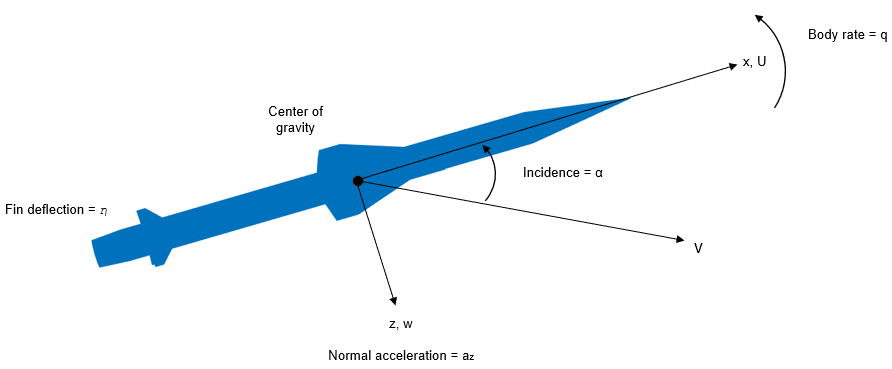
使用 Simulink® 和 Aerospace Blockset™ 创建模型。Aerospace Blockset 提供引用组件,如大气模型,无论弹体配置如何,这些组件对所有模型都是通用的。
打开模型。

在 Simulink 中表示弹体
弹体模型由四个主要子系统构成,由过载指令自动驾驶仪进行控制。Atmosphere & Incidence, Airspeed Computation 子系统计算大气条件随海拔变化的变化。Fin Actuator 和 Sensors 子系统将自动驾驶仪与弹体耦合。Aerodynamics & Equations of Motion 子系统计算作用在导弹体上的力和力矩的大小,并对运动方程进行积分。
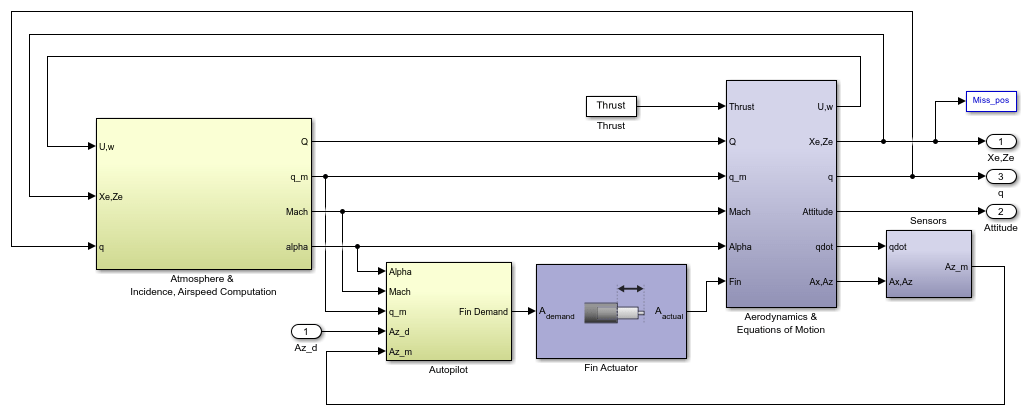
国际标准大气模型
Atmosphere & Incidence Airspeed Computation 子系统是国际标准大气 (ISA) 的近似,分为两个区域。对流层区域位于海平面到 11 千米海拔之间,随着海拔的增加,温度呈线性下降。平流层下部区域在 11 千米到 20 千米海拔之间,温度恒定。

力和力矩的空气动力系数
Aerodynamics & Equations of Motion 子系统产生作用于弹体坐标系的力和力矩,并对定义弹体的线性和角运动的运动方程进行积分。

空气动力学系数存储在数据集中。在仿真过程中,当前工况下的值通过使用 2-D Lookup Table 模块进行插值来确定。
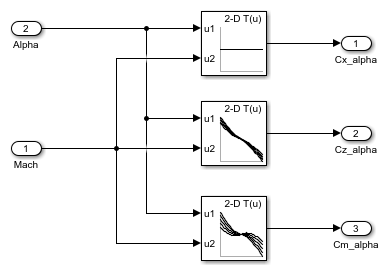
经典三环路自动驾驶仪设计
导弹自动驾驶仪控制导弹体的法向过载。在此示例中,自动驾驶仪的结构采用三环路设计,它使用位于重心前方的加速度计的测量值。它还使用一个速率陀螺仪以提供额外阻尼。控制器增益根据入射角和马赫数进行调度,并在 10000 英尺的海拔进行调整以获得稳健的性能。
使用传统方法设计自动驾驶仪时,必须根据大量配平飞行条件推导弹体俯仰动态的线性模型。MATLAB® 可以确定配平条件,并直接从非线性 Simulink 模型中推导线性状态空间模型。这种方法既节省时间,又有助于验证模型。您可以使用 MATLAB Control System Toolbox™ 和 Simulink® Control Design™ 提供的函数来可视化弹体开环频率(或时间)响应的行为。要了解如何配平和线性化弹体模型,请参阅弹体配平和线性化。
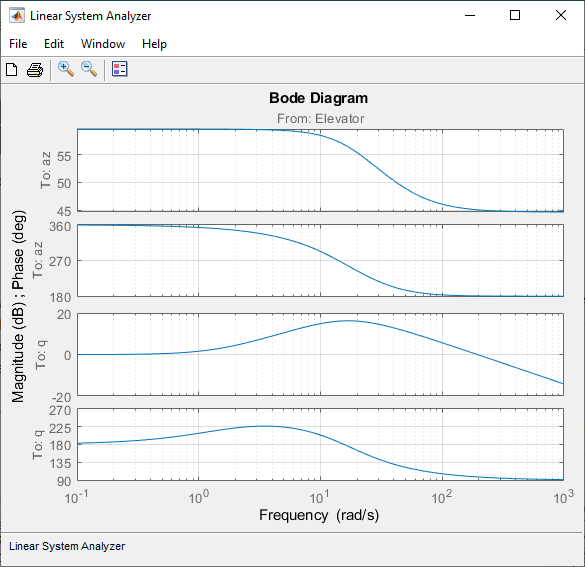
弹体频率响应
自动驾驶仪的设计建立在大量线性弹体模型的基础上,这些模型根据整个预期飞行包线上的各种飞行条件推导而来。为了在非线性模型中实现自动驾驶,必须将自动驾驶增益存储在二维查找表中,并结合抗积分饱和增益,以防止当弹翼指令超过最大限值时积分器饱和。然后,您可以在非线性 Simulink 模型中测试自动驾驶仪,在存在非线性(如作动筒尾翼和速率限制)以及增益随飞行条件变化而动态变化的情况下,显示出令人满意的性能。Autopilot 子系统实现增益调度。
寻的制导环
寻的制导环包含 Seeker/Tracker 子系统,它返回导弹和目标之间相对运动的测量值。Guidance 子系统生成传递给自动驾驶仪的法向过载指令。自动驾驶仪成为整个寻的制导系统的内环的一部分。有关不同制导形式的信息和用于量化制导环性能的分析方法的背景信息,请参阅 [4]。
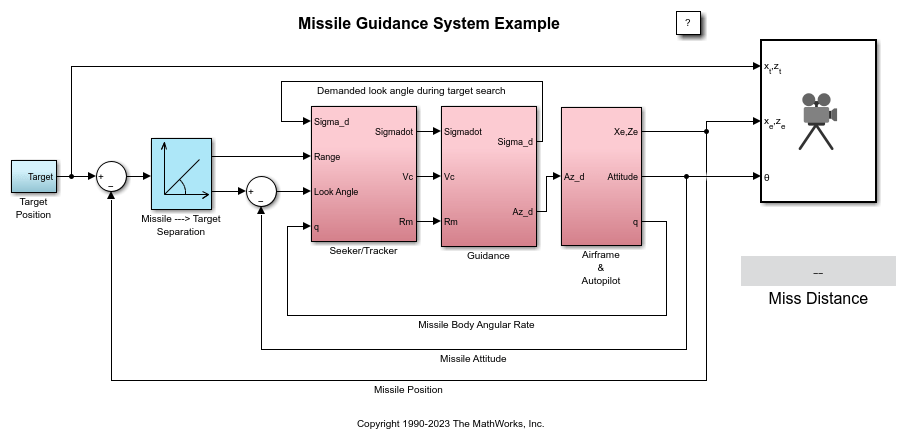
Guidance 子系统
Guidance 子系统在闭环跟踪期间生成指令,并执行初始搜索以定位目标位置。Stateflow® 图控制这些不同操作模式之间的转换。模式之间的切换由在 Simulink 中或在 Stateflow 图内部生成的事件触发。您可以通过更改模式的值来控制 Simulink 模型的行为方式。此变量用于在不同控制命令之间切换。在目标搜索过程中,Stateflow 图通过将指令发送给导引头万向节 (Sigma) 来直接控制跟踪器。一旦目标位于导引头的波束宽度内 (Acquire),跟踪器就会标记目标捕获。经过短暂延迟后,闭环制导启动。Stateflow 功能使系统能够快速定义所有操作模式,例如,当失去目标锁定时或者在目标搜索期间未获得目标时应采取的动作。
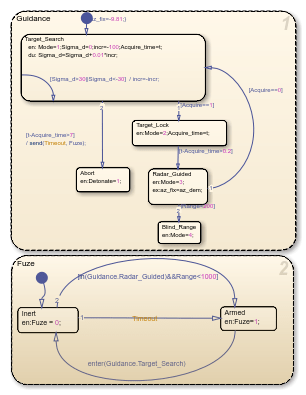
比例导引
一旦导引头获得目标,将使用比例导引 (PNG) 律对导弹进行制导,直到命中目标。这种形式的导引律自 20 世纪 50 年代以来就用于制导导弹,并可应用于雷达、红外或电视制导导弹。导引律需要以下数据:
导弹和目标之间接近速度的测量值(对于雷达制导导弹来说,可使用多普勒跟踪设备获得)
惯性视线角变化率的估计值
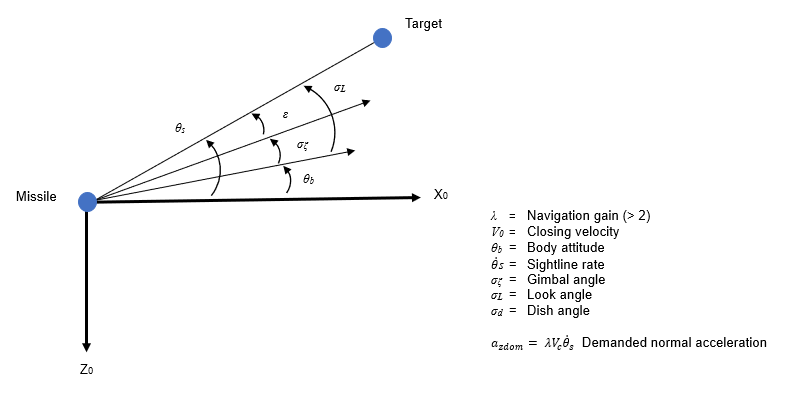
Seeker/Tracker 子系统
Seeker/Tracker 子系统用于驱动导引头万向节,使导引头碟形天线对准目标,并为导引律提供视线速率的估计值。跟踪器环时间常数 tors 设置为 0.05 秒,该值考虑了响应速度最大化,同时将噪声传输保持在可接受水平。稳定环用于补偿弹体滚转速率。增益 Ks(即环路交叉频率)则设置为在稳定速率陀螺仪带宽允许范围内的尽可能高的值。视线速率估计值是以下两个变化速率之和在滤波后的值:由稳定速率陀螺仪测量的碟形角变化速率,以及由接收机测量的角跟踪误差 (e) 变化速率。在此示例中,估算器滤波器的带宽设置为自动驾驶仪带宽的一半。
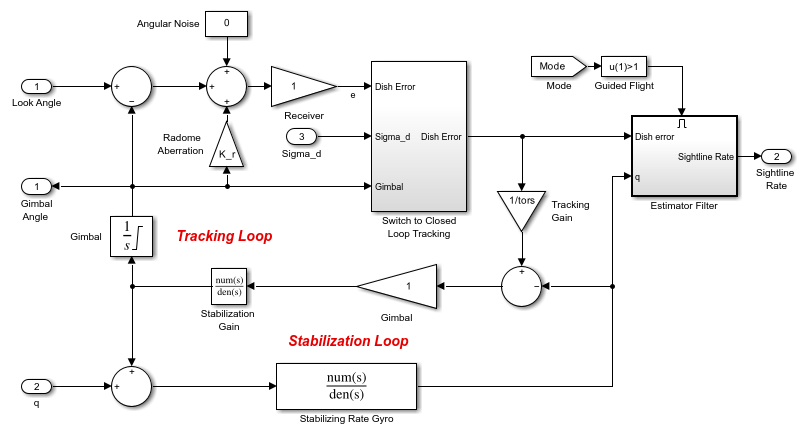
天线罩像差
对于雷达制导导弹,一般建模的寄生反馈效应是天线罩像差。当导引头上的保护罩的形状使返回信号失真并给出目标视角的错误读数时,就会发生天线罩像差。一般情况下,失真量是当前万向节角度的非线性函数。不过,该模型使用名为 Radome Aberration 的 Gain 模块来逼近万向节角度与失真幅度之间的线性关系。您还可以对其他寄生效应(例如速率陀螺仪对法向过载的灵敏度)建模,以测试目标跟踪器和估算器滤波器的稳健性。
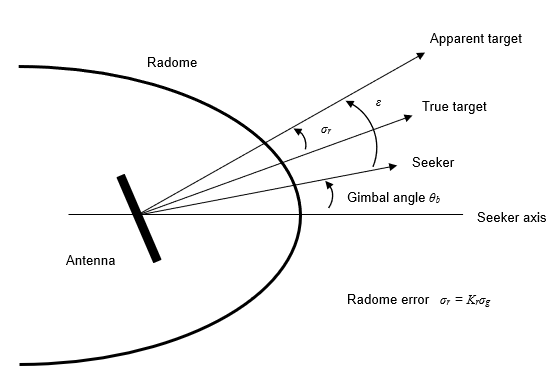
运行制导仿真
现在,您可以测试整个系统的性能。目标已定义为以 328 米/秒的恒定速度与初始导弹航向相向而行,位于导弹初始位置上方 500 米处。仿真结果表明,捕获发生在交会 0.69 秒时,闭环制导在 0.89 秒后开始。与目标的撞击发生在第 3.46 秒,两者在最近会遇点处的距离为 0.265 米。
aero_guid_plot.m 脚本运行性能分析。
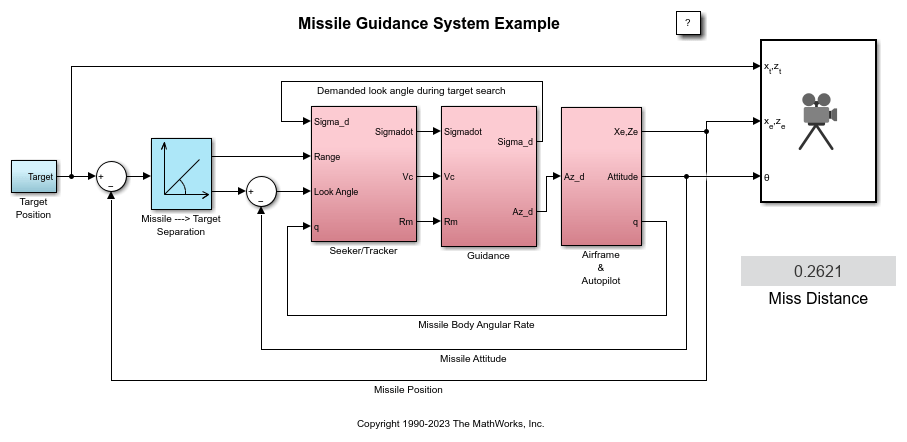
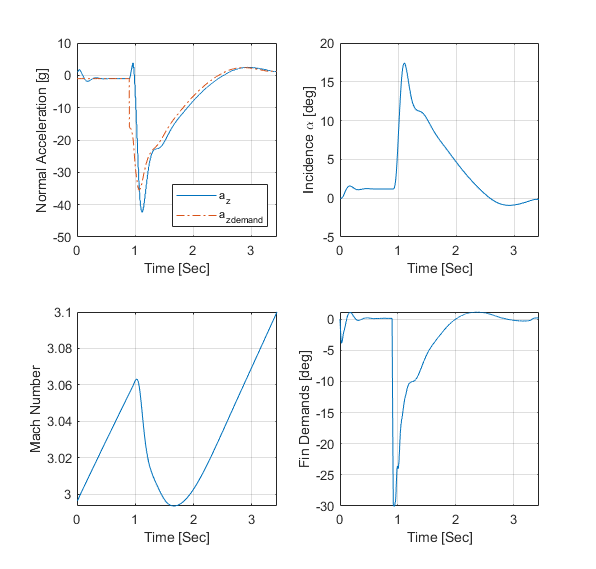
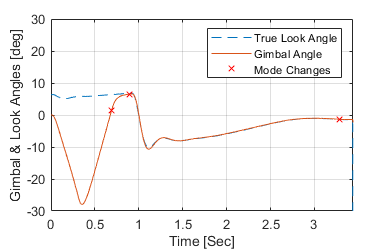

动画模块为仿真提供视觉参考。
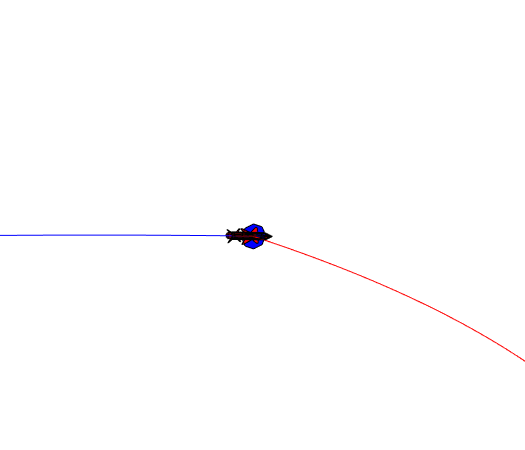
参考
[1] "Bennani, Samir, Dehlia M. C. Willemsen, and Cartsen W. Scherer. "Robust LPV Control with Bounded Parameter Rates." AIAA-97-3641 (August 1997). https://doi.org/10.2514/6.1997-3641.
[2] Mracek, Curtis P., and James R. Cloutier. "Full Envelope Missile Longitudinal Autopilot Design Using the State-Dependent Riccati Equation Method." AIAA-97-3767 (December 1994). https://doi.org/10.2514/6.1997-3767.
[3] Shamma, Jeff S., and James R. Cloutier. "Gain-Scheduled Missile Autopilot Design Using Linear Parameter Varying Transformations.” Journal of Guidance, Control, and Dynamics 16, no. 2 (March 1993): 256–63. https://doi.org/10.2514/3.20997.
[4] Ching-Fang Lin. Modern Navigation, Guidance, and Control Processing. Vol. 2. Englewood Cliffs, NJ: Prentice Hall, 1991.
另请参阅
主题
- Aerospace Blockset
- Create Aerospace Models (Aerospace Blockset)